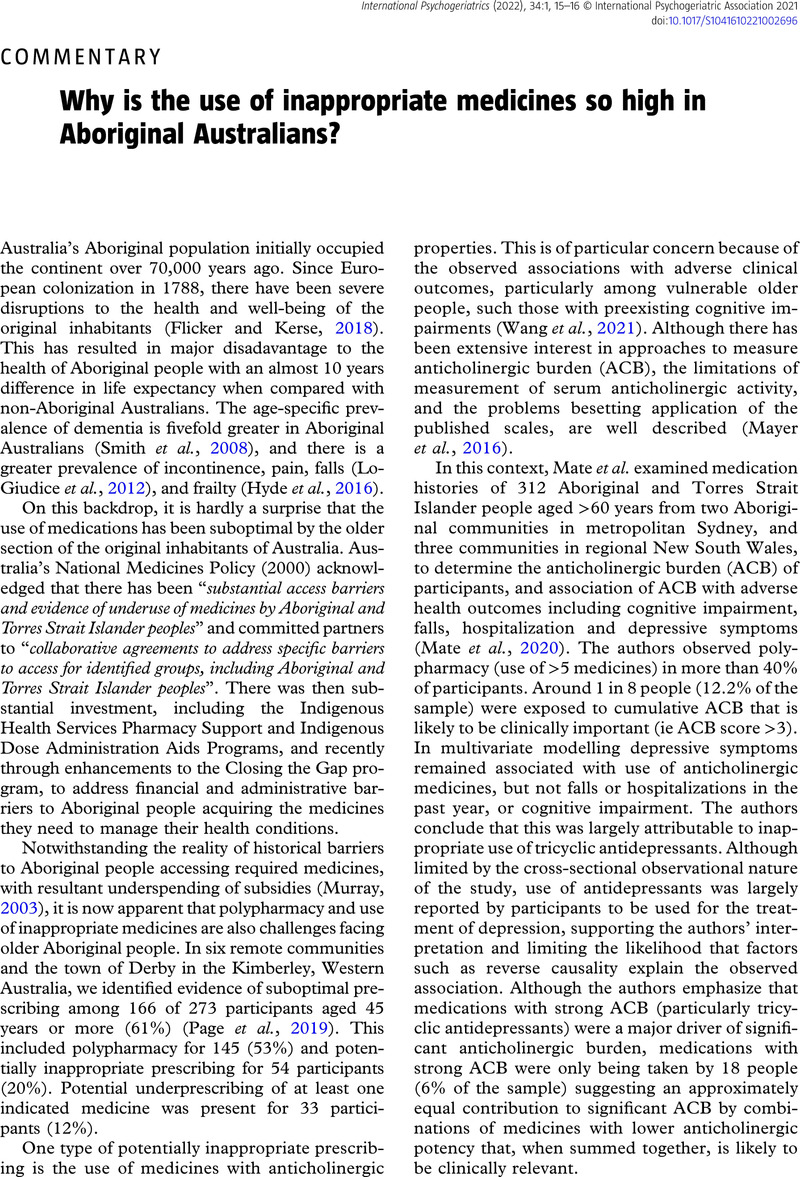No CrossRef data available.
Article contents
Why is the use of inappropriate medicines so high in Aboriginal Australians?
Published online by Cambridge University Press: 11 November 2021
Abstract
An abstract is not available for this content so a preview has been provided. Please use the Get access link above for information on how to access this content.

- Type
- Commentary
- Information
- International Psychogeriatrics , Volume 34 , Special Issue 1: Issue Theme: Varied Angles of Geriatric Depression , January 2022 , pp. 15 - 16
- Copyright
- © International Psychogeriatric Association 2021
References
Flicker, L. and Kerse, N. 2018. Population ageing in Oceania. In: Michel, J. P., Beattie, B. L., Martin, F. C. and Walston, J.D. (Eds.), Oxford Textbook of Geriatric Medicine. Oxford: Oxford University Press.Google Scholar
Hyde, Z. et al. (2016). Prevalence and incidence of frailty in Aboriginal Australians, and associations with mortality and disability. Maturitas, 87, 89–94.CrossRefGoogle ScholarPubMed
LoGiudice, D. C. et al. (2012). Preliminary evaluation of the prevalence of falls, pain and urinary incontinence in remote living Indigenous Australians over the age of 45 years. Internal Medicine Journal, 42, e102–e107.CrossRefGoogle ScholarPubMed
Mate, K. et al. (2020). Use of tricyclic antidepressants and other anticholinergic medicines by older Aboriginal Australians: association with negative health outcomes. International Psychogeriatrics, 34, 71–78. https://pubmed.ncbi.nlm.nih.gov/32985391/.Google Scholar
Mayer, T., Kopitz, J., Plaschke, K., Weiss, J., Seidling, H. M. and Haefeli, W. E. (2016). Limitations of the anticholinergic activity assay and assay-based anticholinergic drug scales. American Journal of Geriatric Psychiatry, 24, 1182–1188.CrossRefGoogle ScholarPubMed
Murray, R. (2003). Prescribing issues for Aboriginal people. Australian Prescriber, 26, 55–57.CrossRefGoogle Scholar
Page, A. et al. (2019). Potentially suboptimal prescribing of medicines for older Aboriginal Australians in remote areas. Medical Journal of Australia, 211, 119–125.CrossRefGoogle ScholarPubMed
Parkinson, L. et al. (2015). Anticholinergic burden in older women: not seeing the wood for the trees? Medical Journal of Australia, 202, 91–94.CrossRefGoogle ScholarPubMed
Smith, K. et al. (2008). High prevalence of dementia and cognitive impairment in Indigenous Australians. Neurology, 71, 1470–1473.CrossRefGoogle ScholarPubMed
Wang, K., Alan, J., Page, A. T., Dimopoulos, E. and Etherton-Beer, C. (2021). Anticholinergics and clinical outcomes amongst people with pre-existing dementia: a systematic review. Maturitas, 151, 1–14.CrossRefGoogle ScholarPubMed




